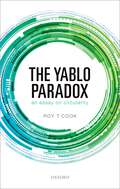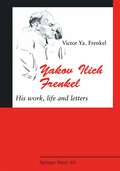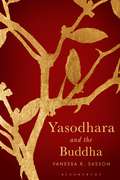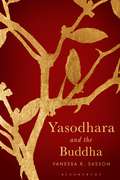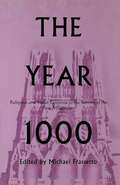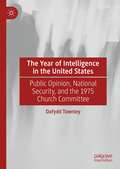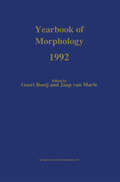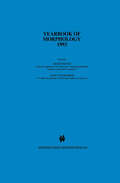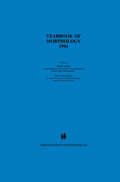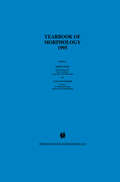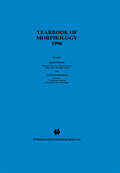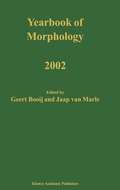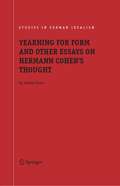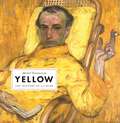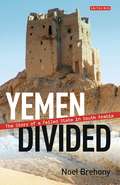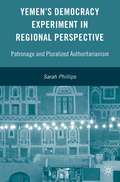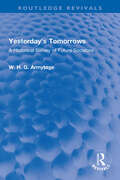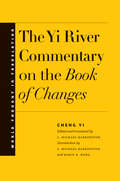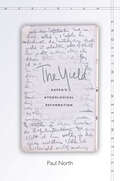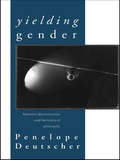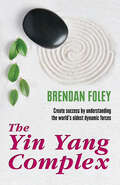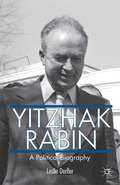- Table View
- List View
The Yablo Paradox: An Essay on Circularity
by Roy T CookRoy T Cook examines the Yablo paradox—a paradoxical, infinite sequence of sentences, each of which entails the falsity of all others later than it in the sequence—with special attention paid to the idea that this paradox provides us with a semantic paradox that involves no circularity. The three main chapters of the book focus, respectively, on three questions that can be (and have been) asked about the Yablo construction. First we have the Characterization Problem, which asks what patterns of sentential reference (circular or not) generate semantic paradoxes. Addressing this problem requires an interesting and fruitful detour through the theory of directed graphs, allowing us to draw interesting connections between philosophical problems and purely mathematical ones. Next is the Circularity Question, which addresses whether or not the Yablo paradox is genuinely non-circular. Answering this question is complicated: although the original formulation of the Yablo paradox is circular, it turns out that it is not circular in any sense that can bear the blame for the paradox. Further, formulations of the paradox using infinitary conjunction provide genuinely non-circular constructions. Finally, Cook turns his attention to the Generalizability Question: can the Yabloesque pattern be used to generate genuinely non-circular variants of other paradoxes, such as epistemic and set-theoretic paradoxes? Cook argues that although there are general constructions-unwindings—that transform circular constructions into Yablo-like sequences, it turns out that these sorts of constructions are not 'well-behaved' when transferred from semantic puzzles to puzzles of other sorts. He concludes with a short discussion of the connections between the Yablo paradox and the Curry paradox.
Yakov Ilich Frenkel
by Victor Ya. FrenkelAn in-depth survey of the genesis and ramifications of Yakov Frenkel’s scientific achievements. Special attention is paid to Frenkel’s civic convictions and numerous other topics. The book contains a wealth of archival documents and is richly illustrated with photos and drawings.
Yasodhara and the Buddha
by Vanessa R. SassonBy combining the spirit of fiction with the fabulism of Indian mythology and in-depth academic research, Vanessa R. Sasson shares the evocative story of the Buddha from the perspective of a forgotten woman: Yasodhara, the Buddha's wife. Although often marginalized, Yasodhara's narrative here comes to life. Written with a strong feminist voice, we encounter Yasodhara as a fiercely independent, passionate and resilient individual. We witness her joys and sorrows, her expectations and frustrations, her fairy-tale wedding, and her overwhelming devastation at the departure of her beloved.It is through her eyes that we witness Siddhattha's slow transformation, from a sheltered prince to a deeply sensitive young man. On the way, we see how the gods watch over the future Buddha from the clouds, how the king and his ministers try to keep the suffering of the world from him and how he eventually renounces the throne, his wife and newly-born son to seek enlightenment. Along with a foreword from Wendy Doniger, the book includes a scholarly introduction to Yasodhara's narrative and offers extensive notes along with study questions, to help readers navigate the traditional literature in a new way, making this an essential book for anyone wanting to learn about Buddhist narratives.
Yasodhara and the Buddha
by Vanessa R. SassonBy combining the spirit of fiction with the fabulism of Indian mythology and in-depth academic research, Vanessa R. Sasson shares the evocative story of the Buddha from the perspective of a forgotten woman: Yasodhara, the Buddha's wife. Although often marginalized, Yasodhara's narrative here comes to life. Written with a strong feminist voice, we encounter Yasodhara as a fiercely independent, passionate and resilient individual. We witness her joys and sorrows, her expectations and frustrations, her fairy-tale wedding, and her overwhelming devastation at the departure of her beloved.It is through her eyes that we witness Siddhattha's slow transformation, from a sheltered prince to a deeply sensitive young man. On the way, we see how the gods watch over the future Buddha from the clouds, how the king and his ministers try to keep the suffering of the world from him and how he eventually renounces the throne, his wife and newly-born son to seek enlightenment. Along with a foreword from Wendy Doniger, the book includes a scholarly introduction to Yasodhara's narrative and offers extensive notes along with study questions, to help readers navigate the traditional literature in a new way, making this an essential book for anyone wanting to learn about Buddhist narratives.
The Year 1000: Religious and Social Response to the Turning of the First Millennium
This collection of new essays examines the long-standing question of apocalyptic expectations around the turn of the first millennium. Including works by scholars of medieval history, literature, and religion, this book argues that apocalyptic expectations did exist around the year 1000. It provides a more balanced and nuanced approach to the issue than the traditional views that either identify a time of fear, the 'terrors of the year 1000', or deny that awareness of the millennium existed. This book, instead, recognizes that there were a variety of responses to the eschatological years 1000 and 1033 and that these responses contributed to the broader social and religious developments associated with the birth of European civilization.
The Year of Intelligence in the United States: Public Opinion, National Security, and the 1975 Church Committee
by Dafydd TownleyThis book will offer a unique approach to the Year of Intelligence, the sixteen-month period between January 1975 and April 1976 that saw the innermost secrets of various US intelligence agencies laid bare before the world. After allegations of intelligence abuses were made in the press, Congress investigated and revealed numerous cases of unwarranted and unconstitutional activity conducted by a number of intelligence agencies. Chief among the investigations was the Senate enquiry, popularly known as the Church Committee after its chairman, Senator Frank Church of Idaho. This study’s objective is to examine the relationship between national security policy and public opinion using extensive archival evidence, including previously unidentified indicators of public opinion. This monograph makes an important contribution to the historiography of the Church Committee, of public opinion, and of national security policy. The research contributes to the debate on the effectiveness of the Church Committee by challenging the conclusions within the established historiography of the limited impact of the committee’s quest for reform. Furthermore, it widens the very limited scholarship that engages with public opinion’s effect on national security policy. And the project also indicates to policymakers the lessons that can be learnt from the case study, principally, that public opinion is a vital ingredient in the decision making process of successful national security policy.
Yearbook of Morphology 1992 (Yearbook of Morphology)
by Geert Booij Jaap Van MarleA revival of interest in morphology has taken place during recent years and the subject is seen now as a relatively autonomous subdiscipline of linguistics. As one of the important areas of theoretical research in formal linguistics, morphology has attracted linguists to investigate its relations to syntax, semantics, phonology, psycholinguistics and language change. The aim of the Yearbook of Morphology, therefore, is to support and enforce the upswing of morphological research and to give an overview of the current issues and debates at the heart of this revival.
Yearbook of Morphology 1993 (Yearbook of Morphology)
by Geert Booij Jaap Van MarleRecent years have seen a revival of interest in morphology. The Yearbook of Morphology series supports and enforces this upswing of morphological research and gives an overview of the current issues and debates at the heart of this revival. The Yearbook of Morphology 1993 focuses on prosodic morphology, i.e. the interaction between morphological and prosodic structure, on the semantics of word formation, and on a number of related issues in the realm of inflection: the structure of paradigms, the relation between inflection and word formation, and patterns of language change with respect to inflection. There is also discussion of the relevance of the notion `level ordering' for morphological generalizations. All theoretical and historical linguists, morphologists, and phonologists will want to read this volume.
Yearbook of Morphology 1994 (Yearbook of Morphology)
by Geert Booij Jaap Van MarleRecent years have seen a revival of interest in morphology. The Yearbook of Morphology series supports and enforces this upswing of morphological research and gives an overview of the current issues and debates at the heart of this revival. The Yearbook of Morphology 1994 focuses on prosodic morphology, i.e. the interaction between morphological and prosodic structure, on the semantics of word formation, and on a number of related issues in the realm of inflection: the structure of paradigms, the relation between inflection and word formation, and patterns of language change with respect to inflection. There is also discussion of the relevance of the notion `level ordering' for morphological generalizations. All theoretical and historical linguists, morphologists, and phonologists will want to read this book.
Yearbook of Morphology 1995 (Yearbook of Morphology)
by JaapMarle GeertBooijA revival of interest in morphology has occurred during recent years. The aim of the Yearbook of Morphology series is to support and enforce this upswing of morphological research and to give an overview of the current issues and debates at the heart of this revival. The Yearbook of Morphology 1995 focuses on an important issue in the current morphological debate: the relation between inflection and word formation. What are the criteria for their demarcation, in which ways do they interact and how is this distinction acquired by children? The papers presented here concur in rejecting the `split morphology hypothesis' that claims that inflection and word formation belong to different components of the grammar. This volume also deals with the marked phenomenon of subtractive morphology and its theoretical implications. Theoretical and historical linguists, morphologists, phonologists and psycholinguists interested in linguistic issues will find this book of interest.
Yearbook of Morphology 1996 (Yearbook of Morphology)
by JaapMarle GeertBooijA revival of interest in morphology has occurred during recent years. Since 1988, the Yearbook of Morphology book series has proven to be an eminent platform for the growth of morphological research, containing articles on topics that are central in the current theoretical debates. The Yearbook of Morphology 1996 focuses on the relationship between morphology and psycholinguistics. Basic questions such as the following are discussed. To what extent does the morphological structure of a word play a role in its perception and production? Are regular complex words created anew each time they are used, or are they stored in the lexicon? The relevant evidence comes from a variety of European languages. Another important theme in this yearbook is the degree of autonomy of morphology: in which respect does it differ from other modules of the grammar? The present yearbook also contains articles on periphrasis, the nature of inflectional morphology and syncretism in derivational morphology. Audience: Theoretical and historical linguists, morphologists, phonologists and psycholinguists will find this book of interest.
Yearbook of Morphology 2002 (Yearbook of Morphology)
by G. E. Booij Jaap Van MarleThe Yearbook of Morphology 2002 discusses the morphology of a variety of pidgin and Creole languages which appear to have much more morphology than traditionally assumed. Other topics include the morphological use of truncation for the coinage of proper names in Germanic and Romance languages, the way affixes are combined and ordered in complex words, and the complex linguistic principles behind these orderings.
Yearning for Form and Other Essays on Hermann Cohen's Thought (Studies in German Idealism #5)
by Andrea PomaHermann Cohen’s philosophy has now, finally, received the recognition it deserves. His thought undoubtedly has all the characteristics of a classic. It faced the great problems of philosophical tradition, with full critical awareness and at the same time, with the capacity to open up new, original routes. It represents one of the last expressions of great systematic thought. The papers collected in this volume deal with different aspects of Cohen’s thought, ethical, political, aesthetic and religious aspectsin particular. However they all represent attempts to follow the ubiquitous presence of certain important themes in Cohen and their capacity for containing meanings that cannot be limited to a single philosophical sphere: themes that are keys to reading unity of inspiration in his thought, which is more deeply imbedded than the exterior architectural unity of his work. The search for the fundamental themes behind Cohen is an important task, if we wish to see this philosopher as a present-day vital point of reference.
Yellow: The History of a Color
by Michel PastoureauFrom the acclaimed author of Blue, a beautifully illustrated history of yellow from antiquity to the presentIn this richly illustrated book, Michel Pastoureau—a renowned authority on the history of color and the author of celebrated volumes on blue, black, green, and red—now traces the visual, social, and cultural history of yellow. Focusing on European societies, with comparisons from East Asia, India, Africa, and South America, Yellow tells the intriguing story of the color’s evolving place in art, religion, fashion, literature, and science.In Europe today, yellow is a discreet color, little present in everyday life and rarely carrying great symbolism. This has not always been the case. In antiquity, yellow was almost sacred, a symbol of light, warmth, and prosperity. It became highly ambivalent in medieval Europe: greenish yellow came to signify demonic sulfur and bile, the color of forgers, lawless knights, Judas, and Lucifer—while warm yellow recalled honey and gold, serving as a sign of pleasure and abundance. In Asia, yellow has generally had a positive meaning. In ancient China, yellow clothing was reserved for the emperor, while in India the color is associated with happiness. Above all, yellow is the color of Buddhism, whose temple doors are marked with it.Throughout, Pastoureau illuminates the history of yellow with a wealth of captivating images. With its striking design and compelling text, Yellow is a feast for the eye and mind.
Yellow: The History of a Color
by Michel PastoureauFrom the acclaimed author of Blue, a beautifully illustrated history of yellow from antiquity to the presentIn this richly illustrated book, Michel Pastoureau—a renowned authority on the history of color and the author of celebrated volumes on blue, black, green, and red—now traces the visual, social, and cultural history of yellow. Focusing on European societies, with comparisons from East Asia, India, Africa, and South America, Yellow tells the intriguing story of the color’s evolving place in art, religion, fashion, literature, and science.In Europe today, yellow is a discreet color, little present in everyday life and rarely carrying great symbolism. This has not always been the case. In antiquity, yellow was almost sacred, a symbol of light, warmth, and prosperity. It became highly ambivalent in medieval Europe: greenish yellow came to signify demonic sulfur and bile, the color of forgers, lawless knights, Judas, and Lucifer—while warm yellow recalled honey and gold, serving as a sign of pleasure and abundance. In Asia, yellow has generally had a positive meaning. In ancient China, yellow clothing was reserved for the emperor, while in India the color is associated with happiness. Above all, yellow is the color of Buddhism, whose temple doors are marked with it.Throughout, Pastoureau illuminates the history of yellow with a wealth of captivating images. With its striking design and compelling text, Yellow is a feast for the eye and mind.
Yemen Divided: The Story of a Failed State in South Arabia
by Noel BrehonySouth Yemen has come to be seen as a potential Al-Qaeda stronghold and at the heart of a separatist movement threatening to rip apart southern Arabia. How has this country of forbidding mountains and arid deserts gone from British colony to communist state and then to 'terrorist base' in just half a century? In "Yemen Divided", author and Middle East expert Noel Brehony tells for the first time comprehensive history of the People's Democratic Republic of Yemen (PDRY). He explains the power politics that came to form a communist republic a few hundred miles from the holiest site in Islam, and the process and conflicts that led to Yemeni unification in 1990. The impact of PDRY is still felt today as unrest continues to escalate across the south. "Yemen Divided" is an important book for anyone wanting to understand why Yemen, sensitive neighbour of Saudi Arabia and strategically vital to Middle East security, has veered towards massive instability.
Yemen’s Democracy Experiment in Regional Perspective: Patronage and Pluralized Authoritarianism
by S. PhillipsThis study examines the nature of changes to Yemen's power structures, political dynamics and institutions since the intention to democratize was announced in 1990 paying particular attention to the role of Yemeni President Ali Abdullah Saleh.
Yesterday's Tomorrows: A Historical Survey of Future Societies (Routledge Revivals)
by W. H. ArmytageFirst published in 1968, Yesterday’s Tomorrows elucidates on the favourite occupation of man: forecasting the future. By man’s predictions, he mirrors his own wish-fulfilments, displacements, projections, denials, evasions and withdrawals. These predications can take the form of countries of the imagination, ‘mirror worlds’ like Rabelais’ Ever-Ever lands or the Erewhon of Butler. Alternatively, they may spring from panic, reflecting fear rather than hope, often manifesting themselves, in our technological age, as reports of ‘flying saucers’ or invasions from another planet. In either form, they provide philosophers, scientists, doctors and sociologists with material for evaluating man’s future needs, offering both criticism of our present society, plans for our future, and release from tension and disequilibrium. Professor Armytage shows in this book how such ‘visions’ can, and do, refresh minds for renewed grappling with the present by arming them with ideas for man’s future needs. He indicates that, out of an apparent welter of futuristic fantasies, a constructive debate about tomorrow is emerging, providing us with operational models of what tomorrow could be. This book will hold special interest for students of philosophy and of English literature.
Yesterday's Tomorrows: A Historical Survey of Future Societies (Routledge Revivals)
by W. H. ArmytageFirst published in 1968, Yesterday’s Tomorrows elucidates on the favourite occupation of man: forecasting the future. By man’s predictions, he mirrors his own wish-fulfilments, displacements, projections, denials, evasions and withdrawals. These predications can take the form of countries of the imagination, ‘mirror worlds’ like Rabelais’ Ever-Ever lands or the Erewhon of Butler. Alternatively, they may spring from panic, reflecting fear rather than hope, often manifesting themselves, in our technological age, as reports of ‘flying saucers’ or invasions from another planet. In either form, they provide philosophers, scientists, doctors and sociologists with material for evaluating man’s future needs, offering both criticism of our present society, plans for our future, and release from tension and disequilibrium. Professor Armytage shows in this book how such ‘visions’ can, and do, refresh minds for renewed grappling with the present by arming them with ideas for man’s future needs. He indicates that, out of an apparent welter of futuristic fantasies, a constructive debate about tomorrow is emerging, providing us with operational models of what tomorrow could be. This book will hold special interest for students of philosophy and of English literature.
The Yi River Commentary on the Book of Changes (World Thought in Translation)
by Cheng YiA translation of a key commentary on perhaps the most broadly influential text of classical China This book is a translation of a key commentary on the Book of Changes, or Yijing (I Ching), perhaps the most broadly influential text of classical China. The Yijing first appeared as a divination text in Zhou-dynasty China (ca. 1045–256 bce) and later became a work of cosmology, philosophy, and political theory as commentators supplied it with new meanings. While many English translations of the Yijing itself exist, none are paired with a historical commentary as thorough and methodical as that written by the Confucian scholar Cheng Yi, who turned the original text into a coherent work of political theory.
The Yield: Kafka's Atheological Reformation (Meridian: Crossing Aesthetics #261)
by Paul NorthThe Yield is a once-in-a-generation reinterpretation of the oeuvre of Franz Kafka. At the same time, it is a powerful new entry in the debates about the supposed secularity of the modern age. Kafka is one of the most admired writers of the last century, but this book presents us with a Kafka few will recognize. It does so through a fine-grained analysis of the three hundred "thoughts" the writer penned near the end of World War I, when he had just been diagnosed with tuberculosis. Since they were discovered after Kafka's death, the meaning of the so-called "Zürau aphorisms" has been open to debate. Paul North's elucidation of what amounts to Kafka's only theoretical work shows them to contain solutions to problems Europe has faced throughout modernity. Kafka offers responses to phenomena of violence, discrimination, political repression, misunderstanding, ethnic hatred, fantasies of technological progress, and the subjugation of the worker, among other problems. Reflecting on secular modernity and the theological ideas that continue to determine it, he critiques the ideas of sin, suffering, the messiah, paradise, truth, the power of art, good will, and knowledge. Kafka's controversial alternative to the bad state of affairs in his day? Rather than fight it, give in. Developing some of Kafka's arguments, The Yield describes the ways that Kafka envisions we can be good by "yielding" to our situation instead of striving for something better.
Yielding Gender: Feminism, Deconstruction and the History of Philosophy
by Penelope DeutscherTraditional accounts of the feminist history of philosophy have viewed reason as associated with masculinity and subsequent debates have been framed by this assumption. Yet recent debates in deconstruction have shown that gender has never been a stable matter. In the history of philosophy 'female' and 'woman' are full of ambiguity. What does deconstruction have to offer feminist criticism of the history of philosophy? Yielding Gender explores this question by examining three crucial areas; the issue of gender as 'troubled'; deconstruction; and feminist criticism of the history of philosophy. The first part of the book discusses the work of Judith Butler, Jacques Derrida, and contemporary French feminist philosophy including key figures such as Luce Irigiray. Particular attention is given to the possibilities offered by deconstruction for understanding the history of philosophy. The second part considers and then challenges feminist interpretations of some key figures in the history of philosophy. Penelope Deutscher sketches how Rousseau, St. Augustine and Simone de Beauvoir have described gender and argues that their readings of gender are in fact empowered by gender's own contradiction and instability rather than limited by it.
Yielding Gender: Feminism, Deconstruction and the History of Philosophy
by Penelope DeutscherTraditional accounts of the feminist history of philosophy have viewed reason as associated with masculinity and subsequent debates have been framed by this assumption. Yet recent debates in deconstruction have shown that gender has never been a stable matter. In the history of philosophy 'female' and 'woman' are full of ambiguity. What does deconstruction have to offer feminist criticism of the history of philosophy? Yielding Gender explores this question by examining three crucial areas; the issue of gender as 'troubled'; deconstruction; and feminist criticism of the history of philosophy. The first part of the book discusses the work of Judith Butler, Jacques Derrida, and contemporary French feminist philosophy including key figures such as Luce Irigiray. Particular attention is given to the possibilities offered by deconstruction for understanding the history of philosophy. The second part considers and then challenges feminist interpretations of some key figures in the history of philosophy. Penelope Deutscher sketches how Rousseau, St. Augustine and Simone de Beauvoir have described gender and argues that their readings of gender are in fact empowered by gender's own contradiction and instability rather than limited by it.
The Yin Yang Complex: Create success by understanding one of the world’s oldest dynamic forces
by Brendan FoleyIn The Yin Yang Complex you will be taken on a journey of discovery that will unearth the reason why the world is in its current state and why you have evolved in the manner that you have. From the Mesolithic period to the modern day, we explore how we have become so unbalanced. He takes ancient knowledge and applies it to our lives today, our businesses, the environment and we see what we can learn. Each chapter has exercises associated with it that will allow you to personally explore your own balance and that in your life. You will learn the keys to great relationships, successful business and all other aspects of your life. This book will give you a comprehensive understanding of the masculine and feminine energies.
Yitzhak Rabin: A Political Biography
by L. DerflerA political and analytical biography, this book examines Yizhak Rabin's longtime leadership of the military and his political direction of the Jewish state, as well as his efforts to secure a peace with Egypt and with the Palestinians.
